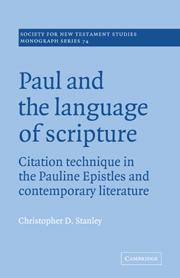 Paul and the Language of Scripture
Paul and the Language of Scripture Book contents
6 - Paul and the text of Scripture
Published online by Cambridge University Press: 05 November 2011
Summary
The last two chapters have produced a massive amount of data on the way Paul handled the text of Scripture in his explicit biblical citations. In accordance with the procedures outlined in chapter 2,only the most secure evidence (A and B ratings) will be used in constructing a portrait of Paul's normal citation technique. In view of the generally conservative method applied throughout the present study, the following conclusions can be affirmed with a reasonable degree of confidence:
(1) Counting the individual verses that make up the so-called “combined citations” (Rom 3.10–18, 9.25–6, 1 Cor 15.54–5, 2 Cor 6.16–18), the present study has examined eighty-three explicit quotations at seventy-four different sites within the assured letters of Paul. Of this number, seventy-six could be identified by the presence of an explicit introductory formula, three by the appearance of specific interpretive comments in the surrounding verses, and four by grammatical incongruities with the new Pauline context.1 Of the seventy-six verses marked by formal introductions, fifty-eight (76 percent) quote individual biblical texts, five (7 percent) conflate verses from more than one passage, and thirteen (17 percent) appear in one or another of Paul's “combined citations.”
(2) It has become common to use the term “introductory formulae” to describe the various phrases that Paul and other New Testament writers use to identify their explicit quotations. In Paul's case, however, such terminology can be rather misleading, since Paul is by no means “formulaic” in the way he incorporates biblical materials into his own compositions.
- Type
- Chapter
- Information
- Paul and the Language of ScriptureCitation Technique in the Pauline Epistles and Contemporary Literature, pp. 252 - 264Publisher: Cambridge University PressPrint publication year: 1992


